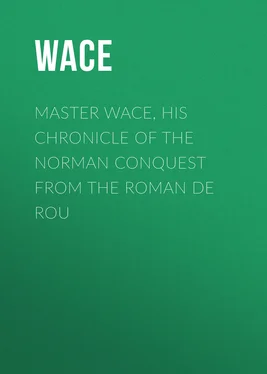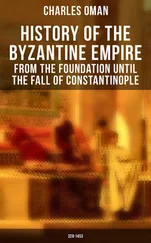Wace - Master Wace, His Chronicle of the Norman Conquest From the Roman De Rou
Здесь есть возможность читать онлайн «Wace - Master Wace, His Chronicle of the Norman Conquest From the Roman De Rou» — ознакомительный отрывок электронной книги совершенно бесплатно, а после прочтения отрывка купить полную версию. В некоторых случаях можно слушать аудио, скачать через торрент в формате fb2 и присутствует краткое содержание. Жанр: foreign_prose, История, foreign_edu, foreign_antique, на английском языке. Описание произведения, (предисловие) а так же отзывы посетителей доступны на портале библиотеки ЛибКат.
- Название:Master Wace, His Chronicle of the Norman Conquest From the Roman De Rou
- Автор:
- Жанр:
- Год:неизвестен
- ISBN:нет данных
- Рейтинг книги:4 / 5. Голосов: 1
-
Избранное:Добавить в избранное
- Отзывы:
-
Ваша оценка:
- 80
- 1
- 2
- 3
- 4
- 5
Master Wace, His Chronicle of the Norman Conquest From the Roman De Rou: краткое содержание, описание и аннотация
Предлагаем к чтению аннотацию, описание, краткое содержание или предисловие (зависит от того, что написал сам автор книги «Master Wace, His Chronicle of the Norman Conquest From the Roman De Rou»). Если вы не нашли необходимую информацию о книге — напишите в комментариях, мы постараемся отыскать её.
Master Wace, His Chronicle of the Norman Conquest From the Roman De Rou — читать онлайн ознакомительный отрывок
Ниже представлен текст книги, разбитый по страницам. Система сохранения места последней прочитанной страницы, позволяет с удобством читать онлайн бесплатно книгу «Master Wace, His Chronicle of the Norman Conquest From the Roman De Rou», без необходимости каждый раз заново искать на чём Вы остановились. Поставьте закладку, и сможете в любой момент перейти на страницу, на которой закончили чтение.
Интервал:
Закладка:
4
A much more correct copy is printed in the french translation of Ducarel, published in 1823.
5
These laments are frequent in the minstrels' songs of that age in all countries. Walther von der Vogelweide, the German minnesinger, by for the most varied and interesting poet of his day, is often very plaintive in his lamentations;
'Hie vor do was diu welt so schöne,
Nu ist si worden also höne,'
The world was once so beautiful,
And now so desolate and dull.'
See notice of his life and works in Lays of the Minnesingers, London, 1825. At the conclusion of his Chronicle, Wace mentions Maistre Beneit (de Sainte-More) as commissioned to undertake a similar task, and expresses himself by no means satisfied with his patron, Henry II.
Mult me duna, plus me pramist:
E se il tot duné m'eust
Ço k'il me pramist, mielx me fut.
6
The names and values of the forty-nine prebends of Bayeux appear in the Mémoires des Antiq. Norm . viii. 458-467. Seven of them were created by Bishop Odo, out of the forfeited lands of Grimoult du Plessis after mentioned.
7
These three Henrys were Henry I. and Henry II. of England, and Henry the latter's son, who died in 1182, in his father's lifetime, but was living when Wace wrote. He was expectant heir of England and Normandy, and was then in the possession or government of the latter, so as in some measure to justify Wace's epithets.
8
Roul is of course the personage usually called Rollo. The sentence in brackets comprises a few words, added by the translator; condensing the intervening part of the Chronicle, so as to introduce that portion of the work which he proceeds to translate.
9
This combat is mentioned by William of Jumieges. Vauquelin or Vauclin is a name still common in Normandy. See as to Ferrieres Mémoires des Antiq, Norm . iv. 434. Vauquelin de Ferrieres left two sons, William and Henry, who distinguished themselves at the conquest, and were liberally rewarded. We shall find the name hereafter.
10
The Montforts will be noticed afterwards.
11
See as to this state of anarchy William of Jumieges, and Ordericus Vitalis . We pass over a portion of the Chronicle, as to the French king's demand of the destruction of Tillieres, and Gilbert Crespin's defence of it, and other disputes with the king.
12
This date is correct; Neel de Saint Sauveur, Viscount of the Cotentin, will be further noticed hereafter. Renouf, Viscount of the Bessin, is afterwards called by Wace Renouf de Bricasard, from the castle of Bricasard, which formed the caput of the barony of the viscounts of the Bessin. Either this Renouf, or a son, married the sister of Hugh Lupus; and their son Ranulpb, of Bayeux or Bricasard, succeeded to the earldom of Chester and other possessions of the Avranche family, on the death of Earl Richard, about 1121. As to the cry of St. Sever, it looks very like an anachronism; unless this Renouf was the one who married the sister of Hugh Lupus, and, being already so married, was sufficiently connected with St. Sever to adopt that war-cry.
13
Guy of Burgundy, or of Maçon, see Wace , i. 352.
14
Brionne, a small town in the arrondissement of Bernay. An account of it and its possessions, and of the acquisition of the castle by Guy of Burgundy, may be seen in Mém. Ant. Norm . iv. 415. It is also described in William of Poitiers .
15
Hamon with the teeth, Lord of Thorigny, in the arrondissement of Saint Lo, father or grandfather of Robert Fitz Hamon, who settled in England, and held lands there. In the roll of Norman fees under Henry II. in the red book of the Exchequer, we find, among the knights of the see of Bayeux, 'Robertus filius Ham. 10 mil. tenebat de honore Ebr.' See as to Thorigny M. de Gerville's Recherches in the Mém. Ant. Norm . v. 220.
16
Grimoult du Plessis, lord of the place still called Plessis-Grimoult, in the arrondissement of Vire. M. de Gerville, in his Recherches, states that besides this Plessis the fief and castle of Plessis in the arrondissement of Coutances, also belonged to Grimoult. He does not determine which of the two gave him his name. We know nothing of his family, except that his sister married William de Albini, great grandfather of the first Albini, Earl of Arundel, whose Cotentin estates were near Plessis.
17
William of Jumieges calls him Gallet; and says he was of Bayeux.
18
The church of St. Clement, a commune at the embouchure of the Vire, near Isigny. The fords of Vire are also mentioned by Wace again in narrating William's rapid journey from Valognes to Arques. He seems to have crossed by the route (abandoned under Louis XIV.) called the Grand-vey (ford), by Montebourg, Emondeville, Surqueville, the Chaussée d'Audouville, and St. Marie du Mont, where the water was entered near Brucheville for Saint Clement, and thence to Rye. Froissart mentions it as the road by which the Earl of Arundel returned to Cherbourg in 1388, after ravaging the Bessin. The great Talbot narrowly escaped by the same road, from an unfortunate expedition. Mém. Ant. Norm , v. 295.
19
Rye, three leagues north of Bayeux. The church of Rye is very ancient and curious. Hubert was the father of five sons—Ralf, Hubert, Adam, Eudo (called Eudo the Dapifer in Domesday,) and Robert, a Bishop.
20
'Entre li mostier es a mote, ' the mound or elevation on which the castle or mansion of Hubert stood; a sense very different from that in which we use the word moat , namely, the surrounding fosse.
21
What spot or stream is here indicated is now, we believe, unknown. It is said there is a Foupendant in the environs of Moutiers, but that there is no stream there.
22
Of Vire.
23
It was, according to Ordericus Vitalis, at Poissy (Pexeium), that William met the King of France, to seek his aid.
24
Rouen, and the district attached.
25
The pays de Lisieux. Oismeiz is the pays d'Exmes.
26
Argences and Mezidon, both situate in the pays d'Auge.
27
Laison.
28
All the topographical details concerning this battle of Val-des-dunes are stated to be perfectly correct, and to show Wace's acquaintance with the neighbourhood.
29
A small district, of which Harcourt-Thury is the principal place.
30
Valmeray, near Croissanville.
31
'Li cumunes,' the troops brought by the barons from their villages and towns. See the very curious passage in Wace , vol. i. page 307, as to another sense of 'cumune,' in his account of the popular insurrection against Duke Richard II.
32
One of the greatest proprietors in Normandy: we shall find his son subsequently, as one of those present at Hastings.
33
Tuit aloent lances levées
Et en totes guimples fermées.
M. Pluquet in his notes interprets guimples as 'cornettes de taffetas attachées à la lance:' for which purpose the knights may have already learned to adopt the colours or tokens of their ladies.
Читать дальшеИнтервал:
Закладка:
Похожие книги на «Master Wace, His Chronicle of the Norman Conquest From the Roman De Rou»
Представляем Вашему вниманию похожие книги на «Master Wace, His Chronicle of the Norman Conquest From the Roman De Rou» списком для выбора. Мы отобрали схожую по названию и смыслу литературу в надежде предоставить читателям больше вариантов отыскать новые, интересные, ещё непрочитанные произведения.
Обсуждение, отзывы о книге «Master Wace, His Chronicle of the Norman Conquest From the Roman De Rou» и просто собственные мнения читателей. Оставьте ваши комментарии, напишите, что Вы думаете о произведении, его смысле или главных героях. Укажите что конкретно понравилось, а что нет, и почему Вы так считаете.












